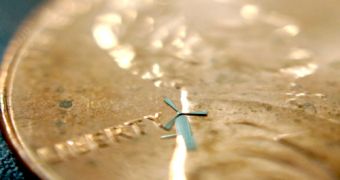Most people are used to seeing folks waving their phones around hoping to get a signal, but, should researchers at the University of Texas at Arlington have their way, there might come a day when all this not-so-coordinated gymnastics could serve one other purpose: getting the gadget moving through the air to charge.
Said scientists have come up with a very innovative means to harvest green energy.
Long story short, they have pieced together miniature windmills that are considerably smaller than a penny, and that, despite their size, appear to be quite efficient as far as harvesting renewables is concerned.
According to Eco Watch, these so-called micro-windmills are the brainchild of Dr. J.-C. Chiao, an electrical engineering professor, and researcher associate Smitha Rao.
By the looks of it, they are so small that about ten of them would have no trouble resting on a single grain of rice, all at the same time. More precisely, they measure 1.8 millimeters at their widest point.
Hence, Dr. J.-C. Chiao and Smitha Rao have high chances to figure out a way to fit hundreds of such devices in a sleeve for a cell phone.
“Imagine that they can be cheaply made on the surfaces of portable electronics so you can place them on a sleeve for your smart phone.”
“When the phone is out of battery power, all you need to do is to put on the sleeve, wave the phone in the air for a few minutes and you can use the phone again,” explains Dr. J.-C. Chiao.
The researcher goes on to explain that those who for one reason or another are opposed to waving could settle for merely holding the gadgets they wish to charge, together with their micro-windmills sleeve, in front of an open window.
Provided that outdoor conditions are windy, the miniature windmills should have no issues producing electricity and then feeding it into the gadgets.
At some point in the future, it might be possible to fit such micro-windmills onto home or building walls, and have them help keep lighting, security and wireless communication systems up and running.
Check out the video below to see one such miniature green energy producing device at work.

 14 DAY TRIAL //
14 DAY TRIAL // 